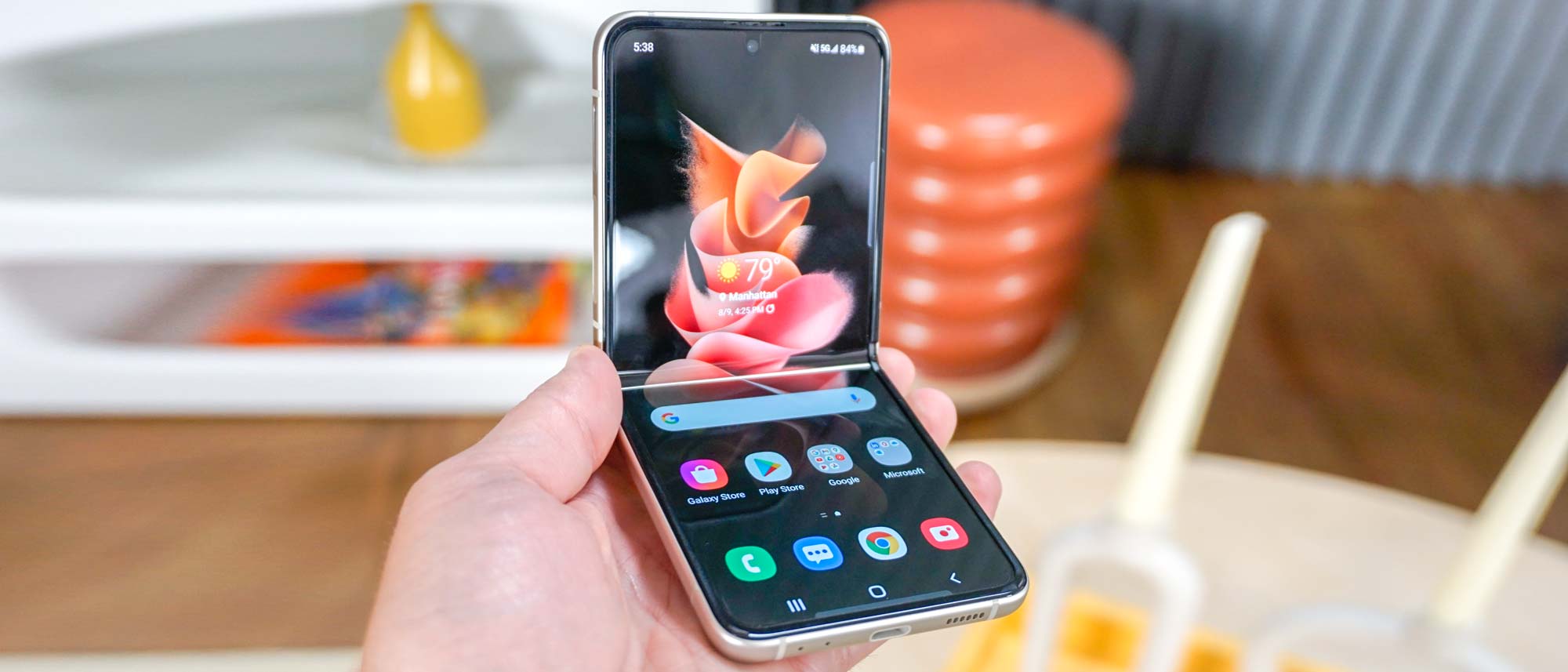Tom's Guide Verdict
With a $999 starting price, the Galaxy Z Flip 3 is an "affordable" foldable, with a 6.7-inch FHD+ inner display with a 120Hz refresh rate. The outer display is four times bigger and more durable than its predecessor, but the 3,300 mAh battery has us worried about the Flip 3’s longevity.
Pros
- +
More affordable
- +
Enhanced durability
- +
Bigger cover display
- +
120Hz refresh rate on inner display
- +
IPX8 water resistance
Cons
- -
Short battery life
- -
Slow charging
- -
No telephoto lens
- -
Crease is still noticeable
Why you can trust Tom's Guide
Price: $999 (128GB), $1,049 (256GB)
OS: Android 11 / One UI 3.1
Inner display: 6.7-inch Super AMOLED (2640 x 1080)
Outer display: 1.9-inch Super AMOLED (260 x 512)
Refresh rate: 120Hz (inner)
CPU: Snapdragon 888
RAM: 8GB
Storage: 128GB, 256GB
Rear cameras: 12MP (f/1.8) main, 12MP (f/2.2) ultrawide
Front camera: 10MP (f/2.4)
Battery: 3,300 mAh
Battery life (Hrs:Mins): 5:43 (adaptive); 6:00 (60Hz)
Charging: 15W wired, 10W wireless
Charger included: No
Size: 3.4 x 2.8 x 0.63-0.67 inches (closed); 6.5 x 2.8 x 0.27 inches (open)
Weight: 6.5 ounces
Editor's note: The Galaxy Z Flip 4 is official, so be sure to check out our Galaxy Z Flip 4 review. And, if you're trying to decide between models, see our Galaxy Z Flip 4 vs. Galaxy Z Flip 3 comparison.
The Galaxy Z Flip 3 was the “cheapest” foldable phone ever at $999 before its successor came along. It was nonetheless a feat worth noting. No, a grand isn’t cheap, but the Galaxy Z Flip 3's price allowed more people to try out the foldable life than ever before, a torch the Galaxy Z Flip 4 now carries.
Will that lower price win people over to the foldable phone side? The Galaxy Z Flip 3 is also more durable than its predecessor, thanks to IPX8 water resistance. The screen is 80% more durable and the phone itself sports Gorilla Glass Victus on the outer display and Samsung’s new Armor Aluminum body. In short, the Z Flip 3 is built to withstand more punishment than the original Galaxy Z Flip, though we still wouldn’t drop it.
Based on our testing, one area where the Galaxy Z Flip 3 majorly stumbles is battery life. It's not pretty. While the Flip 3 is a very good foldable phone for the most part, it's not quite great. Read on for our Galaxy Z Flip 3 review.
Samsung Galaxy Z Flip 3 review: Release date and price
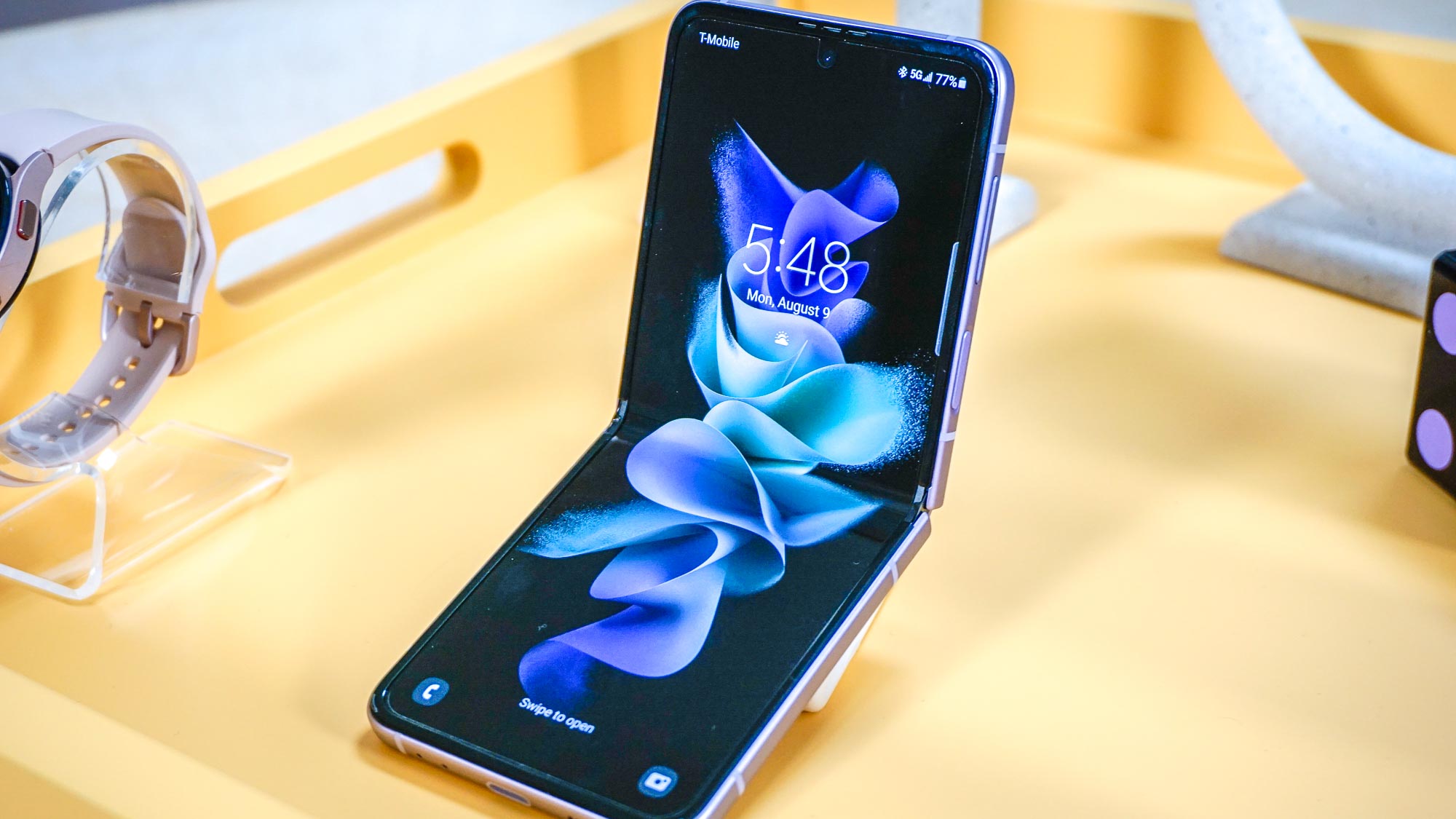
The Galaxy Z Flip 3 is available now. The 8GB/128GB base configuration runs $999, but there’s a 256GB option, too, for $1,049.
Samsung also announced the Galaxy Z Flip 3 Bespoke Edition, which is a customizable phone for $1,099. You have 49 possible color combinations between the frame, front, and back. You can also subscribe to the Bespoke Upgrade Care plan, which lets you trade in your Flip 3 for a different color combination whenever you want. You also get a year of Samsung Care+. Just head over to the Bespoke Studio to get started.
Samsung Galaxy Z Flip 3 review: Design and durability
Samsung took durability seriously with the Galaxy Z Flip 3. The screen is now 80% more durable than the one found on the Galaxy Z Flip and Galaxy Z Flip 5G, thanks to a new film. Gorilla Glass Victus covers the 1.9-inch outer display and Samsung constructed the phone’s frame from its Armor Aluminum material. All of that provides enhanced scratch resistance, especially on the cover display.
Get instant access to breaking news, the hottest reviews, great deals and helpful tips.

Combined with the enhanced durability, the Galaxy Z Flip 3 is truly a marvel of modern engineering.
The Flip 3 also sports IPX8 water resistance. That means you don’t need to worry about dunking it, though neither I nor Samsung would recommend that. We were not able to test the water resistance in our hands-on time with the phone.
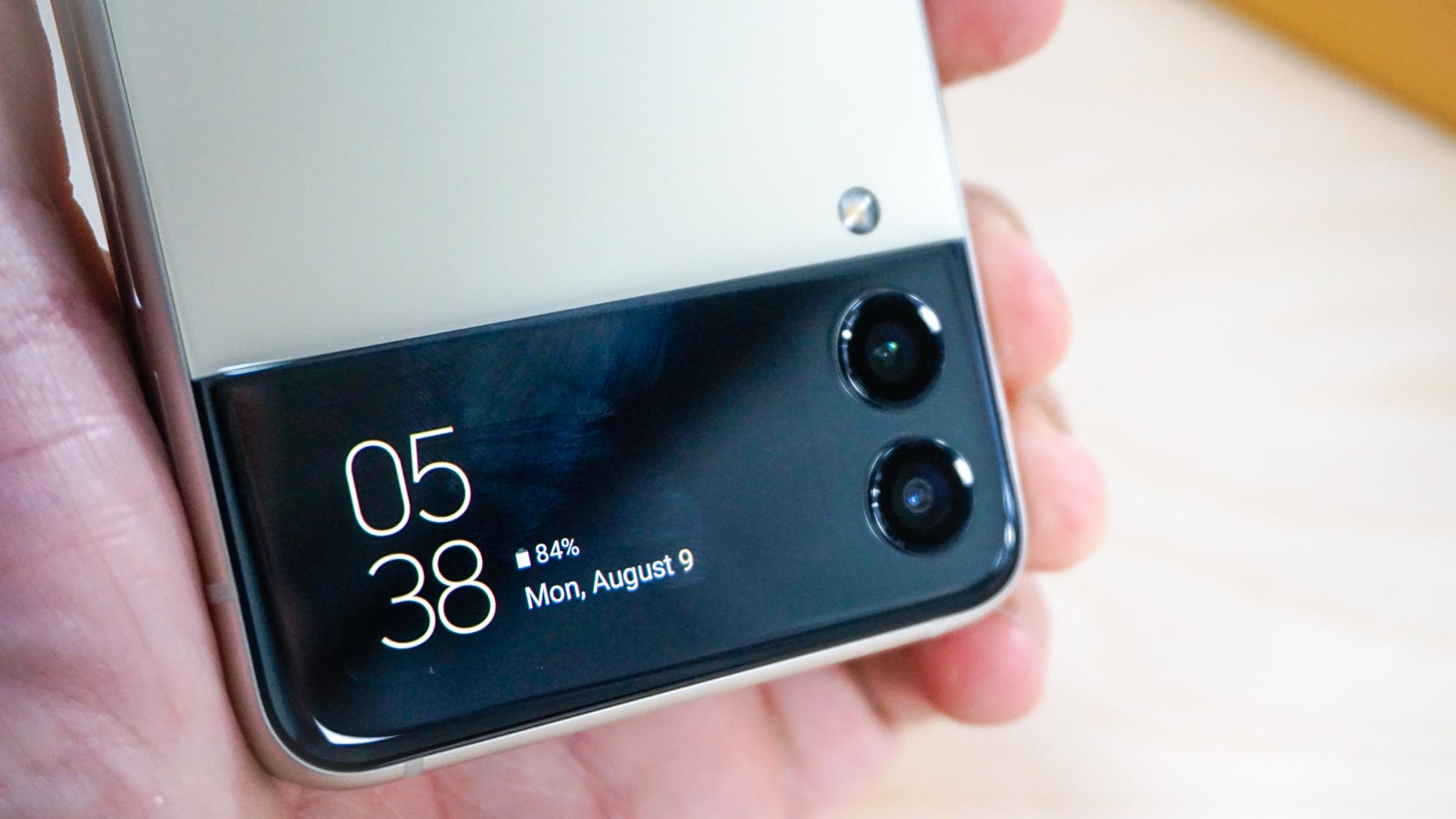
The cover display is probably the biggest change introduced to the Galaxy Z Flip 3’s design. That’s four times larger than the Galaxy Z Flip’s 1.1-inch exterior strip, meaning that you’ll see much more information than before.
The Galaxy Z Flip 3 comes in four colors: Cream, Green, Lavender, and Phantom Black. The lavender really stood out to us in our hands-on, truly catching the eye and exemplifying the Flip 3’s focus on style. Samsung will also offer Gray, Pink, and White colorways exclusively on its website. I’m testing the Cream model and it’s very beautiful in its subtlety. The smooth finish is also really pleasing, considering how slippery the original Galaxy Z Flip was.
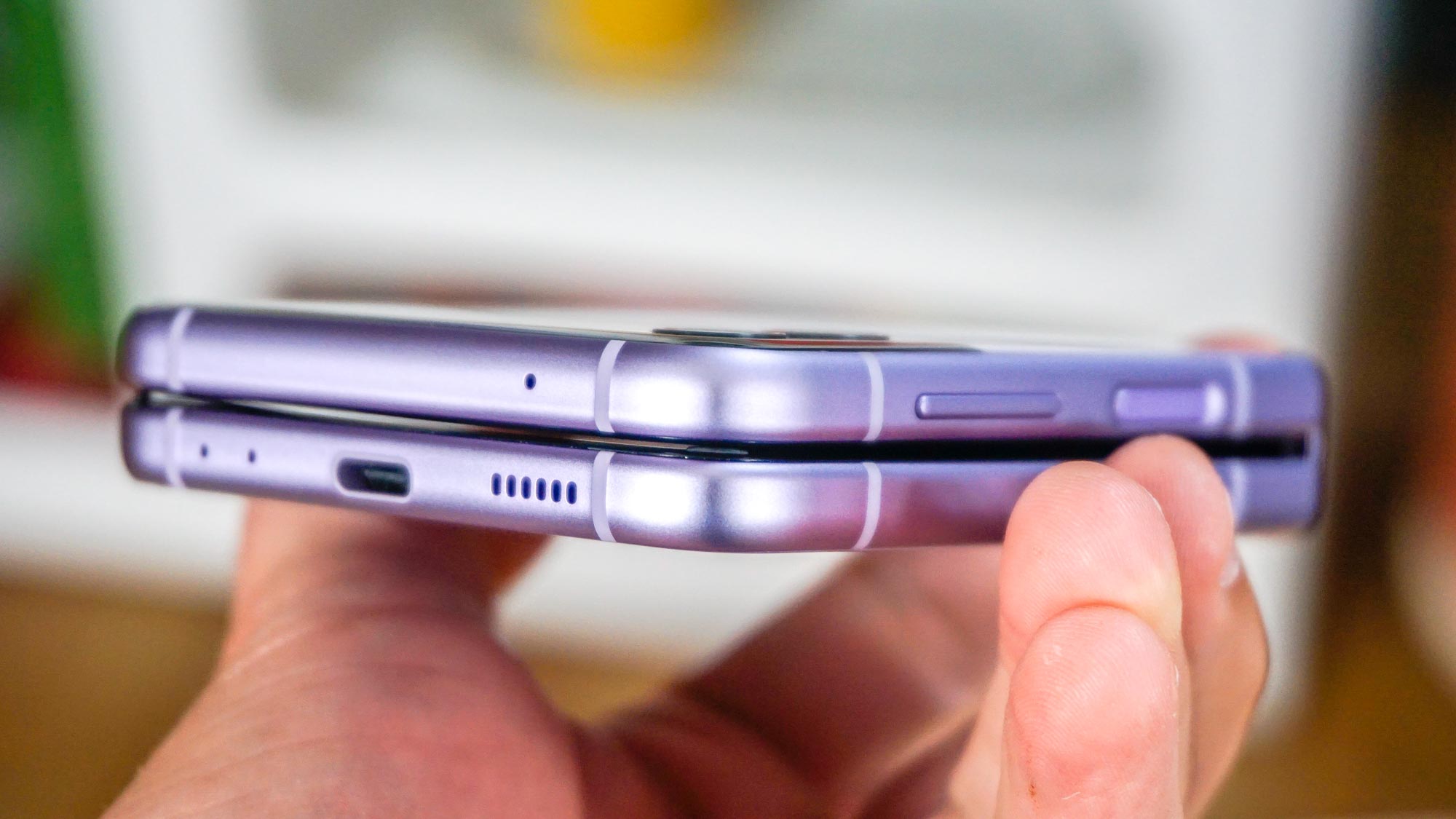
Another big Galaxy Z Flip 3 upgrade involves the phone’s stereo speakers, which got loud enough that we had to turn down the volume in our hands-on session to avoid drowning out nearby conversations. Even when I was listening in on a Tom’s Guide meeting, the speakers still managed to impress me with their clarity. Suffice to say, the Flip 3’s sound system is much better than the original Flip’s.
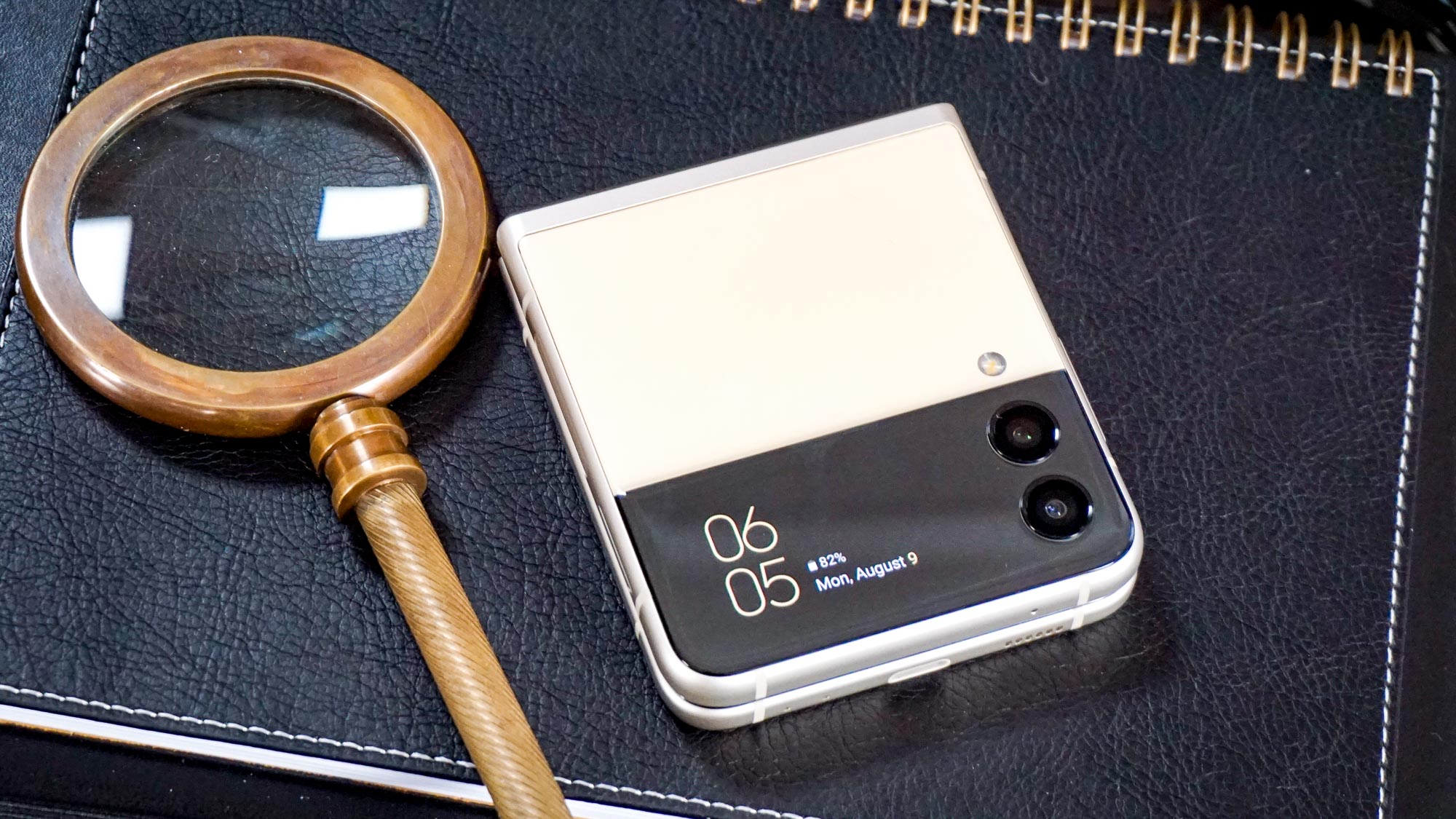
The main appeal of the Galaxy Z Flip 3 beyond its more attractive price remains how pocketable the device is when folded up. When closed, the phone is just 3.4 x 2.8 x 0.63-0.67 inches, meaning it can fit in almost any pocket.
Opened up, the phone measures 6.5 x 2.8 x 0.27 inches, still making for a phone that fits easily in the hand. And at a mere 6.5 ounces (just like its predecessor), the Galaxy Z Flip 3 is easy to take with you anywhere.
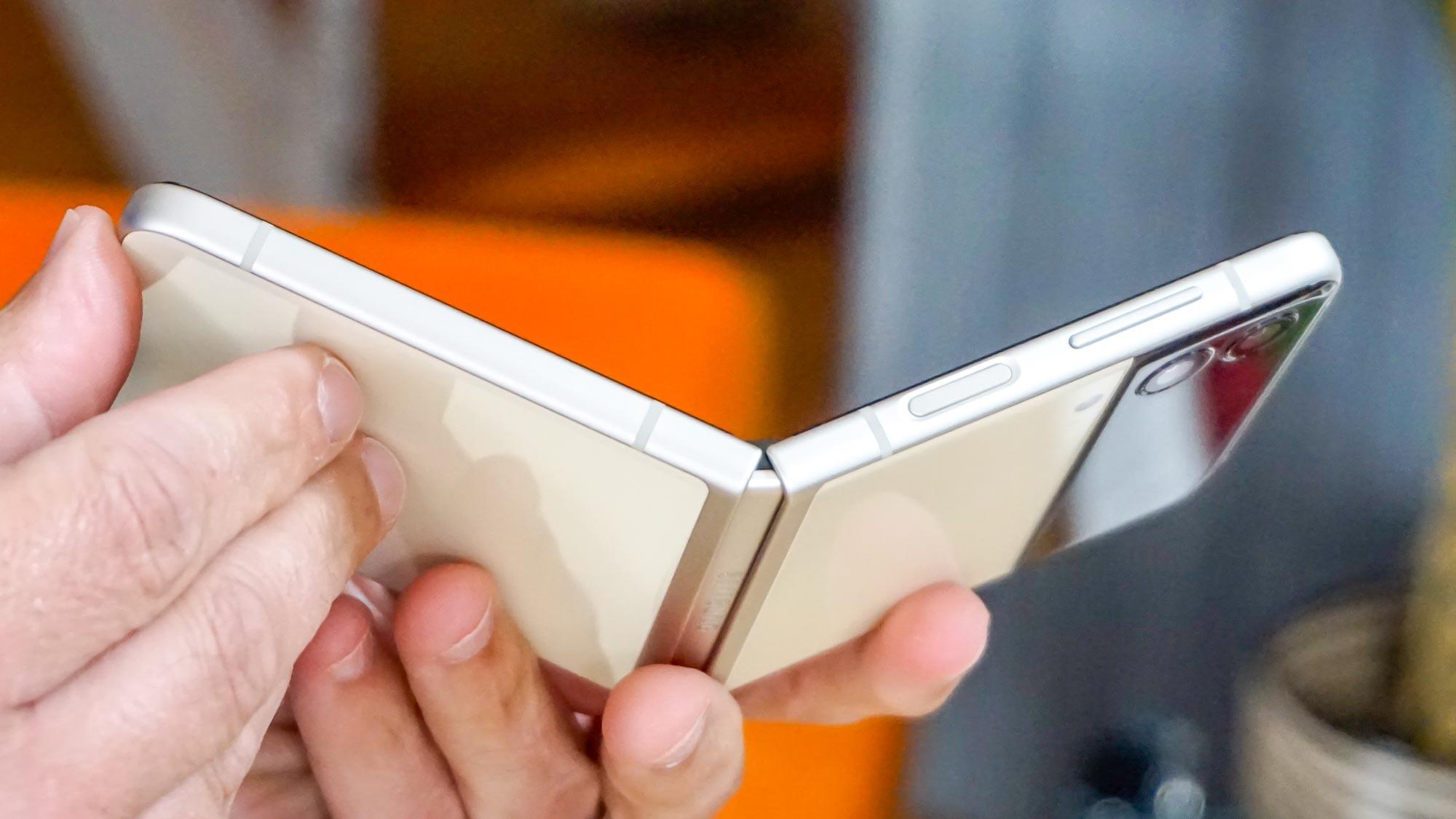
Overall, Samsung slimmed down the Flip 3 ever so slightly. The original Flip measured 6.6 x 2.9 x 0.28 inches when opened and 3.4 x 2.9 x 0.61-0.68 inches when closed. Although the new phone is the same weight, it’s a smidge thinner and taller. Combined with the enhanced durability, the Galaxy Z Flip 3 is truly a marvel of modern engineering.
Samsung Galaxy Z Flip 3 review: Displays
When you unfold the handset, the Galaxy Z Flip 3 sports a 6.7-inch Super AMOLED display. The 2640 x 1080 resolution combined with the 120Hz refresh rate made for a truly beautiful viewing experience. Scrolling was silky smooth with the Flip 3, showing off Samsung’s true display prowess.
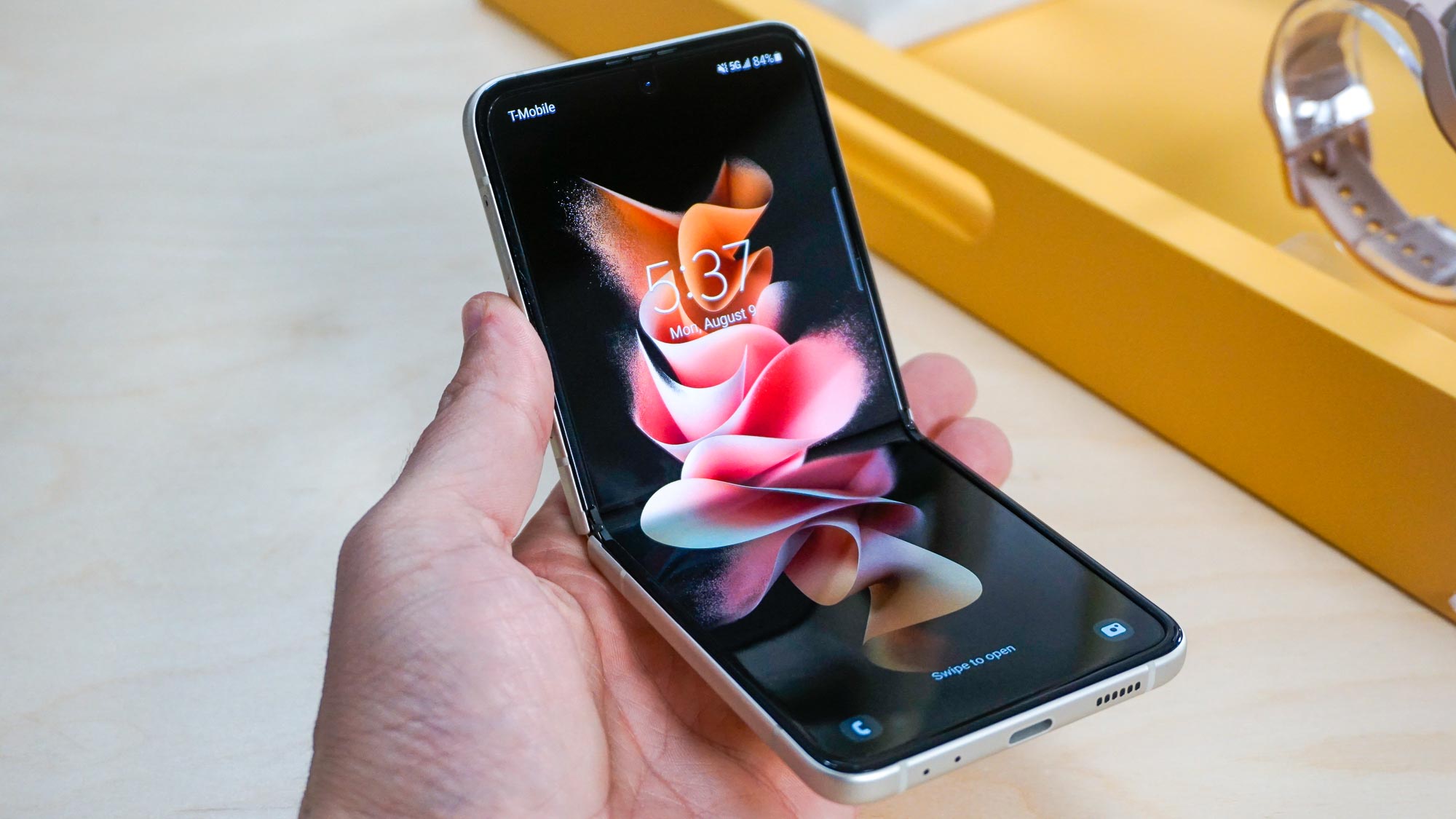
When closed, the 1.9-inch touchscreen lets you control music, check the weather, and even take selfies. (The touchscreen doubles as a viewfinder.) Simply double press the power button to launch the camera and you’re golden. This is a huge improvement over the Flip’s tiny outer display, making the Flip 3 more usable when it’s closed (and thus saving battery life, theoretically).
Compared to the original Flip, I immediately loved the Flip 3’s new cover display. It’s incredibly versatile and useful, allowing you to interact with many major phone functions (and more if you mod it) without opening the device up. By far, it’s my favorite Flip 3 feature outside of the folding itself.
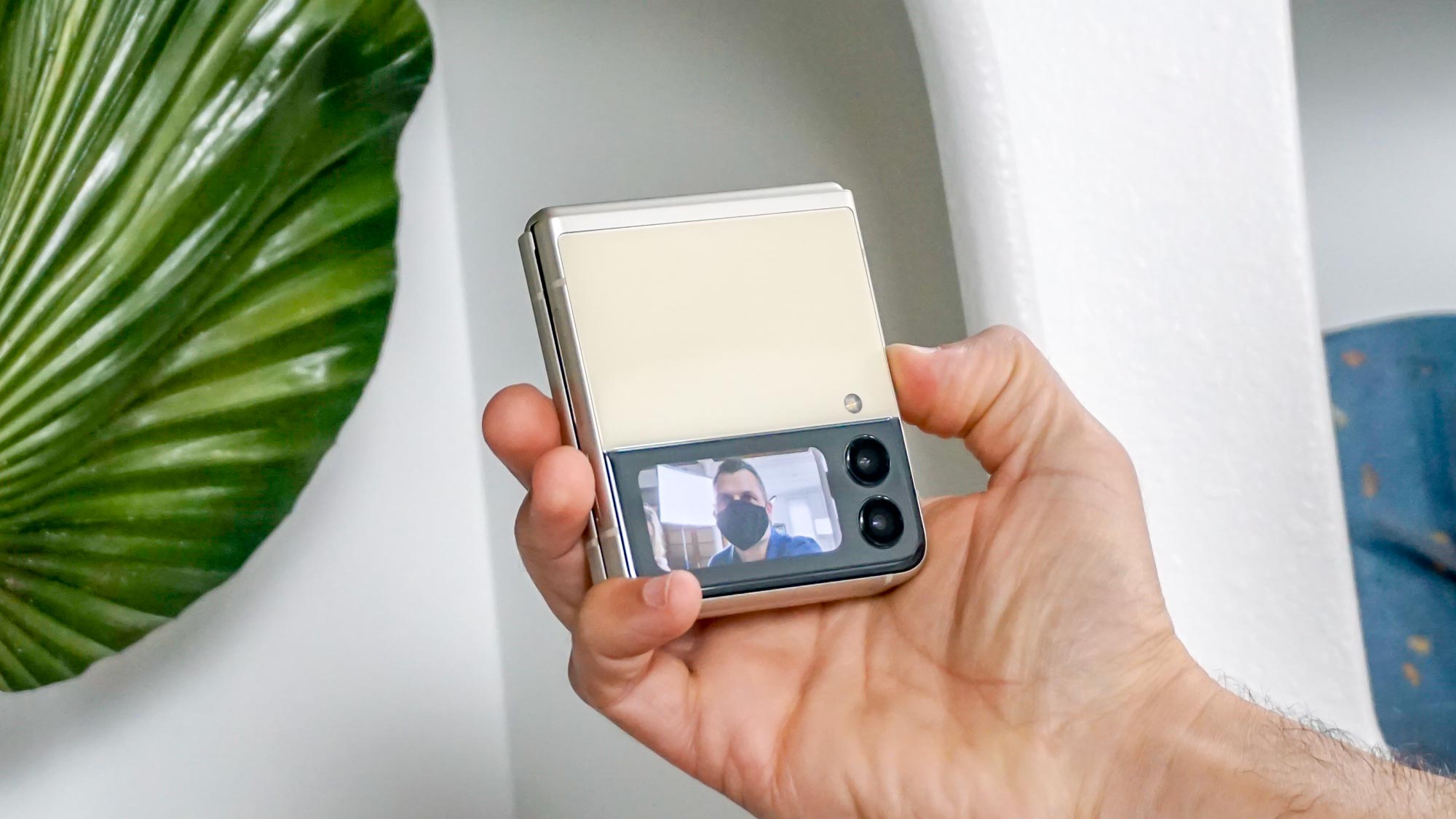
However, one thing that carried over from the original Flip is the crease across the middle of the interior display. It’s still quite noticeable when you scroll over it, even though you may not see it all the time. The image distortion is especially visible in direct sunlight or in apps that use light mode. The visible crease is by no means a deal-breaker, but if you were hoping for something more subtle this time around, you might be disappointed.
The Galaxy Z Flip 3's inner displays reproduced 102% of the sRGB and 76.4% of the DCI-P3 color gamuts. That's actually less saturated than the iPhone 12 Pro's 115.6% sRGB rendering. However, the Galaxy Z Flip 3 has worse better color accuracy with a Delta-E score of 0.32 compared to the iPhone 12 Pro's 0.28. (0 is perfect in this test.)
Samsung Galaxy Z Flip 3 review: Cameras
On the camera front, they’re unchanged from the original Flip. On the back, you get a 12MP (f/1.8) wide-angle shooter and a 12MP (f/2.2) ultrawide one. The selfie camera is 10MP with a f/2.4 aperture. And there is still no telephoto lens on the Galaxy Z Flip 3, unlike other $999 phones such as the iPhone 12 Pro — which I chose to use for the following photo comparisons.
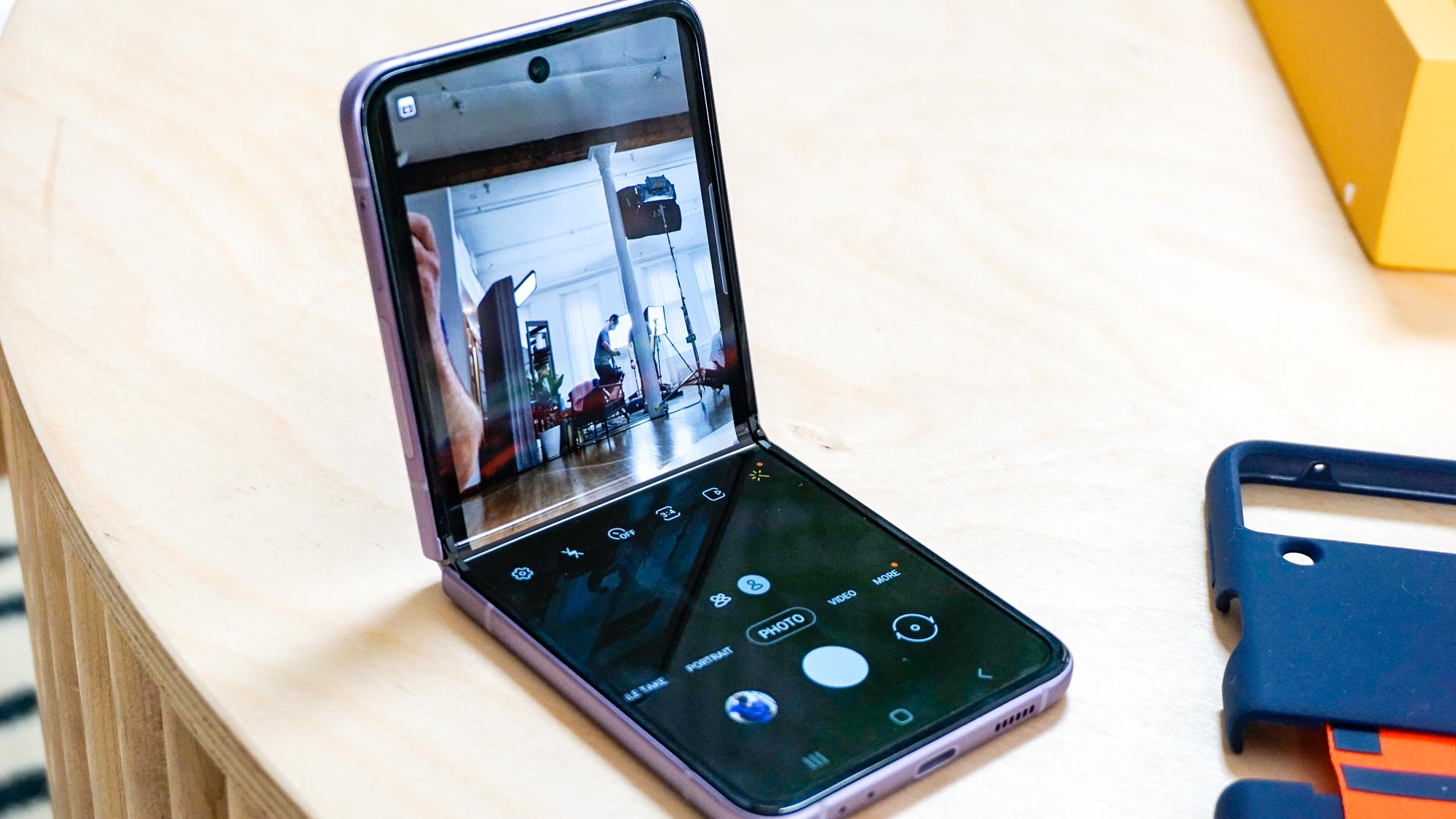
The Flip 3 has its work cut out for it if it’s going to go head-to-head with one of the best camera phones you can buy. And let's not forget that the Galaxy S21 has a telephoto lens and that Samsung works some impressive magic with its those lenses. The Galaxy Z Flip 3’s camera improvements come down to software, offering enhancements to portrait mode and indoor photography.
But now that the Galaxy S22 is the new kid on the block, Samsung has announced that it's bringing some of that phone's camera features to the Galaxy Z Flip 3, like nighttime portraits with the telephoto lens.
Kicking things off is this photo of a copse of trees. Both shots are remarkably similar, but you can see hints of Samsung’s tendency to oversaturate colors in the Flip 3’s photo. The iPhone kept things more toned down. The resulting image isn’t as bright as the Flip 3’s, but its colors are more natural and accurate.
To see how both phones handled direct sunlight, I took a picture of some flowers. This is where the Flip 3 noticeably struggled in comparison to the iPhone. The image looks overexposed, with some of the colors washed out. The iPhone 12 Pro handled the sunlight and colors better, lowering the exposure while showing off the flowers’ brightness.
Heading inside, this photo of a Merida statuette was taken later in the day, so the room isn’t as bright. Even so, the Flip 3’s image is a bit darker than the iPhone’s. That picture looks a bit brighter compared to the dimmer Flip attempt. The iPhone’s shot has more vibrant colors than the Flip’s.
For portraits, you can immediately see two different approaches. The Flip 3’s image is zoomed out more, adding in more of the background surrounding me, but I think I prefer the iPhone’s portrait. Its entire focus is on me and the background in secondary. I also like the iPhone’s stronger bokeh better, too. Samsung still has some work to do with its portrait mode.
Taking a break from the iPhone 12 Pro comparisons for just a second, I brought out the Galaxy S21 Plus to test the Galaxy Z Flip 3’s zoom capabilities. The folding phone has a max digital zoom of 10x, whereas the S21 Plus can crank up to 30x. The S21 also has the Zoom Lock feature, which uses AI to stabilize the image. I’ll let the results speak for themselves on this one.
Heading back over to the iPhone 12 Pro, here’s a shot at night of my smoker. Right off the bat, you can see the differences. While the Flip 3’s night shot isn’t bad, the iPhone’s is clearly better. Not only is the image brighter than the Flip 3’s, but it’s got more details, too. Samsung’s night mode has improved in recent years, but it still has a ways to go before it matches Apple’s.
I tested the Galaxy Z Flip 3’s selfie capabilities using the front lens on the phone’s display. The differences here are more subtle than the other images we’ve looked at, but the Flip 3 applied some face smoothing to my face while the iPhone kept my ruddy complexion. The iPhone’s shot is also a bit warmer, which suited the miserably hot and bright day. I don’t dislike the Flip 3’s selfie, but I prefer the iPhone’s.

Finally, here’s a selfie using the rear cameras with the Galaxy Z Flip 3 closed. Obviously, it’s a better image than the one from the internal front-facing camera, but even with the larger cover screen, lining up the shot properly takes a bit of practice. It’s really convenient, though.
Samsung Galaxy Z Flip 3 review: Video
The Galaxy Z Flip 3 can record video at up to 4K resolution at 60 frames per second. The end result is crisp and smooth, and looks great. The iPhone 12 Pro is also able to record up to 4K 60 fps so I used both phones to record a brief walk to test stabilization, microphone quality, and overall visual fidelity.
The Flip 3’s video is pretty close to the iPhone 12 Pro’s, which is one of the better options for shooting video. Colors in the Flip 3-shot footage were accurate and vibrant, with excellent compensation for the bright daylight. Samsung did a great job with the Flip 3’s stabilization, but the iPhone had better mic quality and background noise isolation. That said, you won’t be disappointed with the Galaxy Z Flip 3’s video recording capabilities.
Samsung Galaxy Z Flip 3 review: Performance
With a Snapdragon 888 and 8GB of RAM, the Galaxy Z Flip 3 is a powerhouse. It didn’t stumble once as I flipped through apps in Flex mode. In short, the Flip 3 feels like any other Snapdragon 888-powered device.
Intensive games like Genhin Impact and Asphalt 9 play beautifully on the Flip 3. I never noticed any frame drops. Games that support higher refresh rates like Dead Cells also play wonderfully on this phone. Of course, battery life is the only hindrance, which I'll get to in a second.

In Geekbench 5, the Galaxy Z Flip 3 scored an impressive 2,984 in multicore. That's not too far off from the iPhone 12 Pro's 3,669. Geekbench isn't necessarily 100% indicative of real-world performance, but it gives an idea of what a system-on-chip like the Snapdragon 888 is capable of.
In the 3DMark Wild Life Unlimited graphics benchmark, the Flip 3 managed an average fps of 27.3. Compare that to the iPhone 12 Pro's whopping 51 fps average.
Finally, in the Adobe Premiere Rush video test — where the phone must transcode a 4K video to 1080p — the Galaxy Z Flip 3 performed the test in 53 seconds. That's pretty good, but the iPhone 12 Pro did it in just 27 seconds.
Samsung Galaxy Z Flip 3 review: Battery and charging
With a 3,300 mAh battery, the Galaxy Z Flip 3 retains the size of the original Flip’s battery capacity. This is cause for some concern, since the Flip’s battery life wasn’t all that impressive. 3,300 mAh is smaller than other Samsung phones, too, including the regular Galaxy S21 with its 4,000 mAh battery.
We tested the Galaxy Z Flip 3's battery in both refresh rate modes and neither was a good result. In its adaptive mode, the Flip 3 lasted for just 5 hours and 43 minutes. In the 60Hz mode, it lasted for a slightly better 6 hours. I've also heard of other reviewers who got abysmally bad battery life, too. The Flip 3's poor battery life significantly detracts from the phone overall.
The original Flip’s battery life lasted for a disappointing 8 hours and 16 minutes. Obviously, there’s not a lot of room for a big battery on the Galaxy Z Flip 3, but there’s now a larger outer display and a 120Hz refresh rate on the inner one, both of which draw more power than before.
Another letdown with the Galaxy Z Flip 3 is the 15W max wired charging. The Galaxy Z Fold 3 supports up to 25W, so I expect charging your Flip will feel slow in comparison. Wireless charging on the Galaxy Z Flip 3 caps out at an even slower 10W.
In our testing, the Galaxy Z Flip 3 recharged from 0% to 22% in 15 minutes, and to 44% in 30 minutes. That's not bad per se, but the battery is also smaller than many Android phones nowadays.
As with the Galaxy S21 series, Samsung won’t be including a charger in the box. We’re not fans of this decision, either.
Samsung Galaxy Z Flip 3 review: Software and Flex mode
The Galaxy Z Flip 3 comes with Android 11 and One UI 3.1 out of the box, with an Android 12 update on the horizon. As with other Samsung phones, you can expect three years of platform updates and four years of security patches with the Flip 3. Samsung’s update policy has paved the way for better support for Android phones, especially in the US where its presence is quite strong.

You can refer to our previous coverage of Samsung devices for our thoughts on One UI 3.1, but it’s a very good rendition of Android. There are a ton of features and enough of Samsung’s design chops to help One UI stand out. In fact, it’s probably the de facto Android experience for many, many people.
But the star of the show isn’t One UI itself, but the software enhancements that Samsung has slapped on to make the Galaxy Z Flip 3 feel useful. Key among those is Flex mode, which significantly bolsters the app user experience where supported.
Flex mode allows you to split UI elements between the two displays. One of the best places to try this out is in the Camera app, where you can have the viewfinder on the top display and the shutter controls on the button. Similarly, you can video call with the phone folded at an angle and sitting on a table — that should help with arm fatigue on long video chats.

One complaint with Flex mode on the Galaxy Z Flip was that there just weren’t that many apps that took advantage of it. YouTube was an exception, letting you watch the video on the top screen and scroll through comments on the bottom one. In fact, when asked, Samsung provided a paltry few apps that support Flex mode — most of the attention was seemingly on the Galaxy Z Fold 3's multi-screen capabilities.
Now that Samsung has announced One UI 4.1 for older Galaxy devices, the Galaxy Z Flip 3 has access to the new Google Duo live sharing feature, Night Portrait mode, and pet recognition in Portrait Mode.
Samsung Galaxy Z Flip 3 review: Verdict
The Galaxy Z Flip 3 addresses a lot of our complaints with the original Galaxy Z Flip. Not only that, but the new phone is even cheaper than the 5G option Samsung released in 2020. A $999 starting price is very attractive to those who might’ve been on the fence about foldables before.
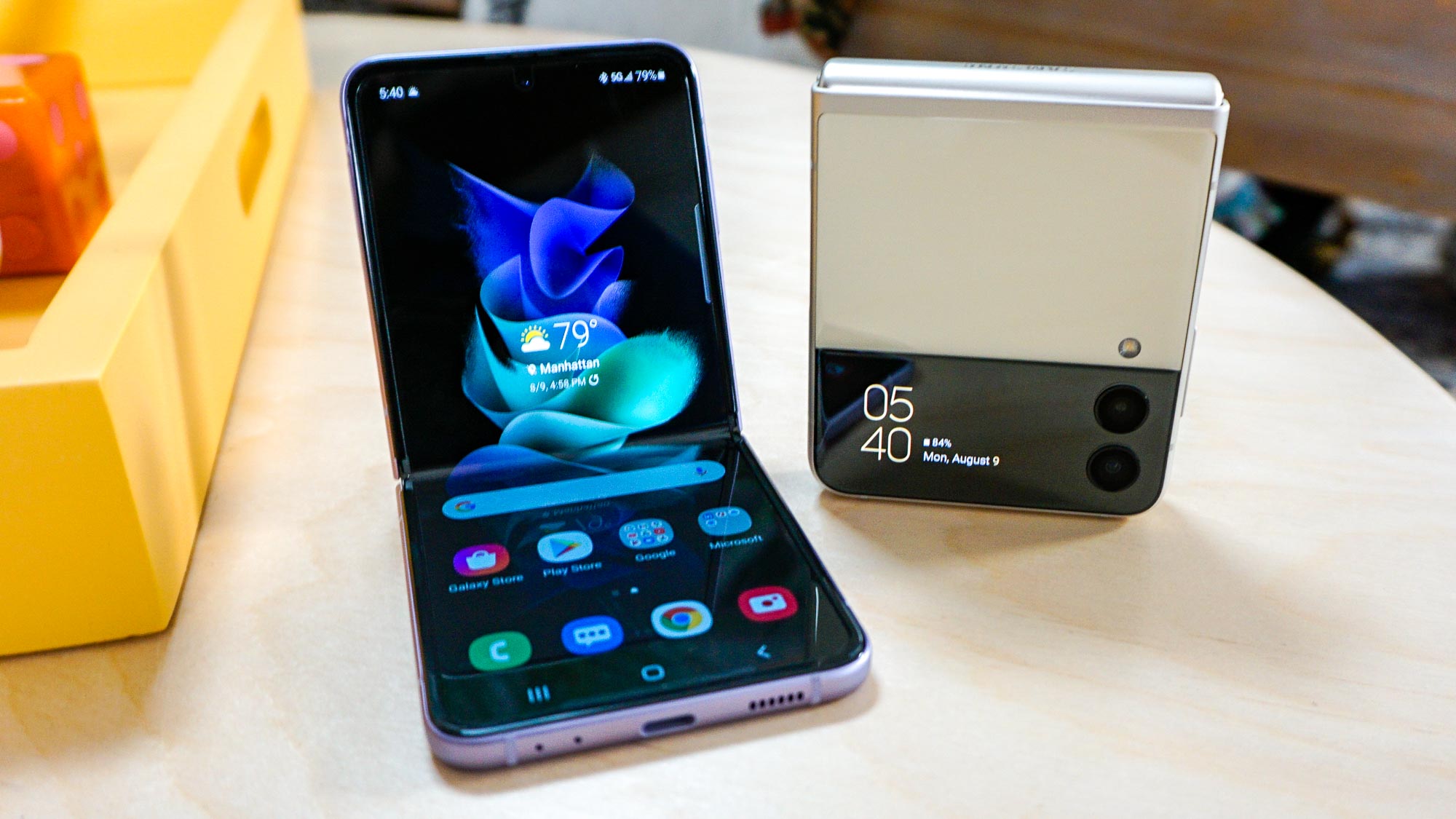
That said, you can get a Galaxy S21 Plus for $999, which has a telephoto lens and better battery life. Furthermore, the Galaxy S21 is just $799 and it also has a telephoto lens. And the Galaxy S21 FE is here, too, with an even lower price tag. Then there’s the $999 iPhone 13 Pro, which is one of the best phones around. In other words, the Flip 3 has a lot of competition and it fails to offer everything that its rivals can. Its terrible battery life certainly doesn't help things.
But the Galaxy Z Flip 3 is meant to push things forward, offering something novel versus the glass and metal slabs we’re so used to nowadays. However, the Flip 3's extremely disappointing battery life gives us pause, making it difficult to recommend this phone in the end. You'll want to keep a charger or battery pack with you if you decide to go with the Galaxy Z Flip 3. And then there's the long-term durability to consider — this technology is still so new and it hasn't thus far proven itself to be reliable long-term.

Jordan is the Phones Editor for Tom's Guide, covering all things phone-related. He's written about phones for over six years and plans to continue for a long while to come. He loves nothing more than relaxing in his home with a book, game, or his latest personal writing project. Jordan likes finding new things to dive into, from books and games to new mechanical keyboard switches and fun keycap sets. Outside of work, you can find him poring over open-source software and his studies.
